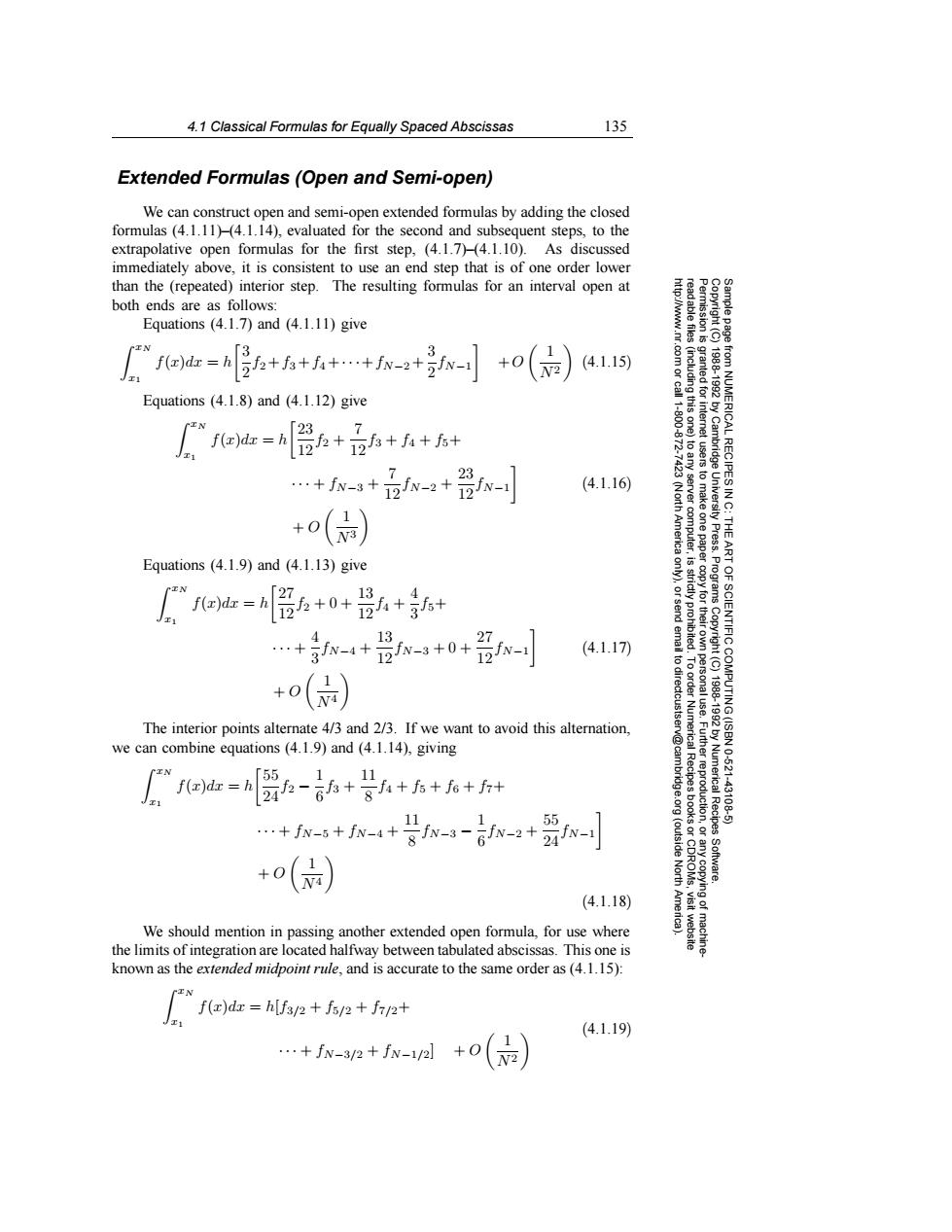正在加载图片...

4.1 Classical Formulas for Equally Spaced Abscissas 135 Extended Formulas(Open and Semi-open) We can construct open and semi-open extended formulas by adding the closed formulas (4.1.11)(4.1.14),evaluated for the second and subsequent steps,to the extrapolative open formulas for the first step,(4.1.7)(4.1.10).As discussed immediately above,it is consistent to use an end step that is of one order lower than the(repeated)interior step.The resulting formulas for an interval open at both ends are as follows: Equations (4.1.7)and (4.1.11)give e=++h++-+-+o() 41.15) 9 Equations (4.1.8)and (4.1.12)give a地=器+品+h++ 1872 …+a++器- (4.1.16 (Nort serve make one paper University Press. 9 +(a) America computer, THE Equations (4.1.9)and (4.1.13)give ART =侣+0+++ 13 9 Programs send …+3-4+-3+0+ 4 13 (4.1.17) +() ectcustser The interior points alternate 4/3 and 2/3.If we want to avoid this alternation, 1788-1982 OF SCIENTIFIC COMPUTING(ISBN 0-521- we can combine equations (4.1.9)and (4.1.14),giving f(a)dz= [贸a-+号++6++ 55 1 55 Numerical Recipes -4310-5 …+fN-5+fN-4+ 8fN-3- 6fN-2 24fN-1 (outside +o() North Software. (4.1.18) We should mention in passing another extended open formula,for use where the limits of integration are located halfway between tabulated abscissas.This one is known as the extended midpoint rule,and is accurate to the same order as (4.1.15): f(x)dx=h[f3/2+f5/2+f/2+ (4.1.19) …+fN-3/2+fN-1/2l+O4.1 Classical Formulas for Equally Spaced Abscissas 135 Permission is granted for internet users to make one paper copy for their own personal use. Further reproduction, or any copyin Copyright (C) 1988-1992 by Cambridge University Press. Programs Copyright (C) 1988-1992 by Numerical Recipes Software. Sample page from NUMERICAL RECIPES IN C: THE ART OF SCIENTIFIC COMPUTING (ISBN 0-521-43108-5) g of machinereadable files (including this one) to any server computer, is strictly prohibited. To order Numerical Recipes books or CDROMs, visit website http://www.nr.com or call 1-800-872-7423 (North America only), or send email to directcustserv@cambridge.org (outside North America). Extended Formulas (Open and Semi-open) We can construct open and semi-open extended formulas by adding the closed formulas (4.1.11)–(4.1.14), evaluated for the second and subsequent steps, to the extrapolative open formulas for the first step, (4.1.7)–(4.1.10). As discussed immediately above, it is consistent to use an end step that is of one order lower than the (repeated) interior step. The resulting formulas for an interval open at both ends are as follows: Equations (4.1.7) and (4.1.11) give xN x1 f(x)dx = h 3 2 f2+f3 +f4+···+fN−2+ 3 2 fN−1 +O 1 N2 (4.1.15) Equations (4.1.8) and (4.1.12) give xN x1 f(x)dx = h 23 12f2 + 7 12f3 + f4 + f5+ ··· + fN−3 + 7 12fN−2 + 23 12fN−1 + O 1 N3 (4.1.16) Equations (4.1.9) and (4.1.13) give xN x1 f(x)dx = h 27 12f2 +0+ 13 12f4 + 4 3 f5+ ··· + 4 3 fN−4 + 13 12fN−3 +0+ 27 12fN−1 + O 1 N4 (4.1.17) The interior points alternate 4/3 and 2/3. If we want to avoid this alternation, we can combine equations (4.1.9) and (4.1.14), giving xN x1 f(x)dx = h 55 24f2 − 1 6 f3 + 11 8 f4 + f5 + f6 + f7+ ··· + fN−5 + fN−4 + 11 8 fN−3 − 1 6 fN−2 + 55 24fN−1 + O 1 N4 (4.1.18) We should mention in passing another extended open formula, for use where the limits of integration are located halfway between tabulated abscissas. This one is known as the extended midpoint rule, and is accurate to the same order as (4.1.15): xN x1 f(x)dx = h[f3/2 + f5/2 + f7/2+ ··· + fN−3/2 + fN−1/2] + O 1 N2 (4.1.19)��������